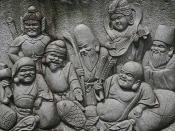Until the advent of the Prophet Muhammad, founder of Islam during the years between 622-632, tribal jealousies and divisions between clan and clan had prevented the growth of the Arabs into a nation. (1). Through Islam and its intentions of being a religion of humanity, universal brotherhood, and a faith that was shaped by the belief in the oneness of God which would therefore bring about the oneness of its people these were changed. Arabs finally attained a type of uniformity. Their beliefs took on a more cohesive shape, and through these they gained more power than they had ever had. (2). Following the death of the Prophet in 632, these were however lost and torn to pieces by angry passions and the lust for power. (3). Internecine, strife and discord, again came to dominate and served to generate divisions and frustration which later became causal factors generating in schisms and even beliefs which contradict the soul foundations of Islam.
The results of these saw the division of the great Islamic Umma, (community) into two major branches, the Sunnites and the Shiites, and numerous offshoots, some of which are today seen to be more similar to Christianity or Judaism than to Islam.
The Prophet Muhammad who later was to change the face of the Arab world was born at around the year 570, in Mecca. (4). At about the year 610, he received the first of a series of revelations that convinced him that he had been chosen as Godôs messenger and thus, began to preach the message entrusted to him, that there is but one God, to whom all humankind must commit themselves. (5) At Medina Muhammad won acceptance as religious and military leader, (6) and within a few years he had established control of the surrounding region.



Very biased essay
Whilst you may think you presnt a fair two sided arguement, you turn a blind eye on many key events that have taken place in history. I would strongly suggest you read this book: http://www.al-islam.org/restatement/index.htm before coming up with such fringe arguments undermining the shiite sector.
Ahmed
1 out of 1 people found this comment useful.